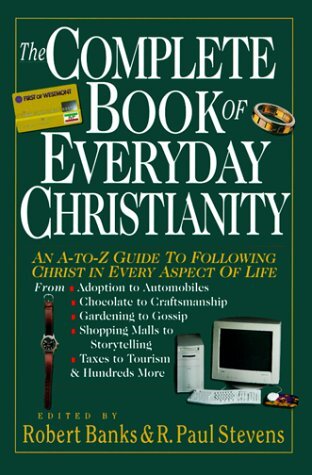Faith Development
Book / Produced by partner of TOW
Faith is not just a single act, though faith often begins with a single act. Nor is it only a body of doctrine to which one gives assent, though what one believes can be described in statements of faith. Faith is an action, a commitment of one’s life to Jesus Christ. “To faith” (Fowler, Faith Development) is a process of continual growth, development and Christian nurture from less to more mature stages. Faithing is as much a verb or action as it is a noun. The concept of spiritual growth and development is found throughout Scripture. The disciples ask for an increased faith (Luke 17:5). Faith continues to grow (1 Cor. 3:1-6; 2 Cor. 10:15). Luke describes Jesus’ childhood development as growing “in wisdom and stature, and in favor with God and men” (Luke 2:52).
Fowler’s Stages of Faiths
James Fowler, probably the foremost researcher on faith development in the last twenty years, has provided useful perspectives on faith and faith development. Fowler states that a person comes to the activity of faithing through one’s community. For children that community is at first their parents. The community expands to include their churches’ teachers and pastors, their denomination and eventually a community of committed believers regardless of denominational affiliation. According to Fowler, community consists of three parts: the persons themselves, their faith community and the object of their faith community’s faith, namely, God. Fowler describes six stages of faith:
Stage One: Projective Faith. This faith development stage is based on the authority of one’s family and/or primary caregivers. People in this stage imitate their authority figures and copy what they do. Ultimate reality for stage one persons is whatever the authority figures say is true and ultimate. Children believe what their parents tell them to believe about God, Jesus, the Bible, heaven and so on.
Stage Two: Mythic-Literal Faith. Authority in this stage is based on an enlarged community of faith, usually one’s own church and its teachers and pastors. The enlarged community helps define the content and object of faith. Ultimate reality is what one’s church teaches.
Stage Three: Synthetic-Conventional Faith. The person synthesizes and identifies with a larger group of believers beyond his or her immediate church and accepts their explanation of ultimate reality. This is the stage when catechism, church membership and the like are important. People in this stage accept the standard doctrines and other teachings of their church and of people in their denomination. Hence the word synthetic-conventional. At the earliest this stage usually occurs in the young adolescent years and can continue throughout adulthood. Probably most adults are in this stage and will never become more mature. They hold tenaciously to their faith and clearly identify with the larger faith community beyond their family, friends and local church.
Stage Four: Individuating-Reflective Faith. Persons at this stage begin to evaluate and self-consciously reflect on the issues and problems associated with their faith commitments. This is the stage when one clearly internalizes one’s faith. Ultimate truth is understood not just because it was taught by one’s faith community and acceptable doctrines of the church, but because it has been critically examined and accepted as one’s own. There is a strong commitment to this. This stage usually begins in late adolescence or adulthood, but many adults never develop this far. People at this stage think through the issues of their faith. Much thinking, talking and critical examination take place during this stage. Long discussions occur regarding seemingly paradoxical issues such as human free will versus the sovereignty of God and other theological conundrums.
Stage Five: Paradoxical-Consolidated Faith. This is clearly a stage of faith development that even few adults achieve. People at this stage recognize the validity of others’ beliefs yet clearly internalize their own. Their own faith is clearly and consciously held together with the recognition that “all truth is God’s truth.” A person at this stage goes beyond the clearly defined theological formulas and continues to probe deeper, higher and broader to discover more of God’s revelation. They live in the tension of having accepted clearly defined truth for oneself and yet recognizing that one has glimpsed only a small part of the ocean of God’s truth. There is more to be known of God than the creeds and church can teach us. We are responsible to search more to know the God of our own faith.
Stage Six: Universalizing Faith. This stage is very rare. The paradoxes and complexities of one’s faith that have been wrestled with in the previous stages become less important compared to being swept up into the oneness of being in Christ. Ultimate truth is perceived not just as propositional but as relational. This stage calls forth a radical commitment to the ethics of the kingdom and an active participation in working out the righteousness of the kingdom of God in this present age.
One of the problems with Fowler’s approach to faith development is that it describes a generic developmental faithing process regardless of the object of one’s faith. His description is as easily applicable to a Hindu as to a fundamentalist Christian and to all religious and/or quasi-religious faith. An atheist goes through similar stages of “faithing” as a Christian. What is different is the object of their commitment. When we apply Fowler’s contributions on faith development to the Christian faith, we need to do so with insights from Scripture and a critical eye toward his stage descriptions. For Christians it is not just the development of faith that is important but also the development of faith in the triune God of Scripture. A mature faith in an incorrect or inappropriate object is ultimately worthless.
Christian Faith Development
Nevertheless, Fowler has provided great insight into stages of faith development. Using Fowler’s contributions, we can view the stages of Christian faith development from within a Christian framework.
Stage One: Simple Faith. The basic characteristic of this stage is a childlike faith. This is the faith of a child or person who, like a child, places his or her trust in Christ and asks few if any questions. People may or may not grow out of this stage. They can be stunted or entrenched into a nonthinking adoption of whatever the authority (pastor, teacher, radio or TV preachers) says is the right thing to believe, accept and do. These persons are highly dependent on other persons’ directions, instructions and the correct interpretation of the meaning of the Bible. These are bottle-fed, milk Christians always needing someone to nurture and care for them spiritually. These people go to church, Bible studies or conferences to be fed spiritual food. Unknowingly, sometimes, they snack on Christian fast foods and Christian junk food that appear good but are ultimately not going to nurture. They read their Bible because others tell them to do so. They learn because authorities teach them. Interpretation of the Bible, right and wrong behaviors, doctrines to believe, rituals to perform are received from others. They take no personal responsibility for their own spiritual growth and development. They apply teachings in a literal and rather mechanical, uncritical fashion. If the authority does not tell people at this stage what to do, then they will not make any changes in their behavior or thinking.
Stage Two: Identification and Beginnings of Internalization. These persons are still highly dependent on the input from external authorities. They receive Christian content and direction primarily from external sources. What distinguishes these people from stage one people is that they are beginning to filter their life’s experiences and thoughts through their rudimentary personal faith. They begin to realize their own personal responsibility for their spiritual growth. Just like a child knows it is hungry and must eat, so these people realize the need to pursue spiritual nutrition. People begin to ask, “How does my faith interact with what I am being told?” They continue to go to others to find out how their faith is to function and interact with their experiences. Discipling and mentoring become important here because authorities are still considered models to copy. Categories of faith development and faith thinking are few and still immature (some are just plain shallow).
Stage Three: Internalization/Identification. Persons at this stage recognize their need for input from others, but they also recognize that they have a personal responsibility to grow up spiritually and not be so dependent on others. They still need and seek guidance and input from others, but they process this input in a new way. They do not uncritically accept and act because some respected authority says so. They take responsibility for their own spiritual decisions. Models and mentors are still important for these people because these serve to help them to search, feed and grow. Realizing that they are responsible for their own spiritual development, they maintain contact with their former primary authority source for general guidance rather than particular directions. Categories of faith are filled primarily by one’s self with some additional input from others.
Stage Four: Internalization. People at this stage realize that they are ultimately responsible for their spiritual growth. They must feed themselves. They cannot be dependent on stimulation from other people. Nor do they want more Christian fast food from conferences. Models and mentors serve as external reminders of what they were becoming when dependent on others. Now the categories and content of their faith are filled almost exclusively by their own actions. Their lives are being changed because they themselves actively seek to have the Holy Spirit change them. Contact with others is important for community and mutual encouragement, not for spiritual milk.
Stage Five: Sustaining. People at this stage keep on keeping on. As Paul said, they are doing “everything to stand . . . firm” (Ephes. 6:13). They continually seek God in and for all aspects of their lives. Models and mentors are not necessary and are sometimes distractions. Categories and content of faith are filled, renewed, rearranged and revised as they read, study and meditate on Scripture and as the Holy Spirit interacts with their own hearts and minds. They walk in the Spirit. They realize that they must strive mightily to present themselves as mature in Christ (see Col. 1:20-23). Their lives are being changed consistently because of their own constant seeking for spiritual renewal and development. They are “spiritually self-actualizing” Christians. The Christian community is a place for corporate worship and ministry with the internal community and from which to minister to the world.
» See also: Life Stages
» See also: Spiritual Formation
» See also: Spiritual Growth
References and Resources
J. Astley and L. Astley, eds., Christian Perspectives on Faith Development (Grand Rapids: Eerdmans, 1992); C. Dykstra and S. Parks, Faith Development and Fowler (Birmingham, Ala.: Religious Education Press, 1986); J. W. Fowler, Becoming Adult, Becoming Christian (San Francisco: Harper & Row, 1984); J. W. Fowler, Stages of Faith: The Psychology of Human Development and the Quest for Meaning (San Francisco: Harper & Row, 1981); L. Kuhmerker, et al., The Kohlberg Legacy for the Helping Profession (Birmingham, Ala.: Religious Education Press, 1991).
—John M. Dettoni





